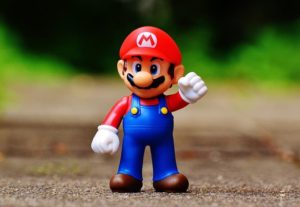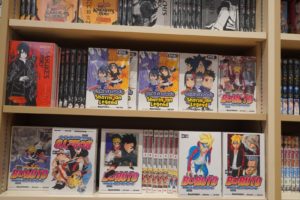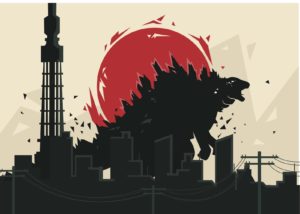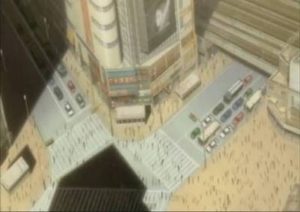Mario Segale, the landlord of Nintendo’s Washington warehouse in the 1980s, probably never expected to become the namesake of a video game character whose “net worth” would accrue to $805 billion. At the time, the video game character—a little man with a big nose, a black mustache, and overalls—was named “Jumpman,” a side character in Nintendo’s new Donkey Kong product. Nintendo’s American executives wanted a catchier name. When the video game’s creator, Shigeru Miyamoto, caught wind that warehouse workers had started calling the character “Mario” due to his resemblance to the Washington landlord, Nintendo adopted the name for the release of Donkey Kong Jr.
In the three decades since, Mario remains a global icon: pseudo-Italian plumbers in Mario costumes can be found parading the streets on Halloween every year, perhaps largely unaware of their homage to Miyamoto and Mario Sigale. Meanwhile, anime forums and conventions have proliferated, Pokémon card-trading crazes swept past schoolyards across the globe, and a new generation of global mega-hits such as One Piece and Naruto spawned multi-decade runs and a steady stream of new fans.
How did Japanese video games and anime come to be such a dominant force in U.S. pop culture? And what are the secret ingredients that make these franchises from across the Pacific not only such resounding instant successes, but ones with such longevity?

The History of Japanese Pop Culture’s Global Boom
Japan’s global image abroad as a pop export factory traces its recent roots back to postwar Japan. Reconstruction efforts after World War II provided important socioeconomic and technological conditions for Japan’s creative industry. Just as in the United States, a “baby boom” generation was born in Japan to a rising economic class, buoyed by the reconstruction. This ballooning population of young consumers provided a prime audience for the expansion of media, such as broadcast television shows and serialized manga magazines, like Weekly Shonen Jump, launched in 1968.

Prominent Japanese artist Takashi Murakami observed that pop culture in the second half of the 20th century became the processing realm for Japan’s postwar tensions. Common themes ranged from the infantilization of Japan (kawaii/cute culture) to preoccupation with deformity (mutants and monsters). To reflect on the atomic bombings of Hiroshima and Nagasaki, many Japanese creators turned to ideas of post-war discontent, heroic escapism, social stagnation, and moral ambiguity.
For example, Godzilla, familiar to many Western viewers as a rampaging reptile, was conceived as a peaceful creature who turned violent and wreaked destruction after mutations from atomic radiation.
After Godzilla met U.S. audiences in 1956, the 1960s saw a gradual import of Japanese anime such as Astro Boy and, most notably, the hit series Battle of the Planets. Fast forward to the late 70s, and Japanese companies such as Sony and Matsushita (now, Panasonic) were gaining global renown for their technical products.

In 1985, Nintendo came onto the scene, making waves in the U.S. market with the mass popularity of its gaming console. As a U.S. gaming industry expert recalled to the New York Times in 1988: “It’s a mania… For boys in this country between the ages of 8 and 15, not having a Nintendo is like not having a baseball bat.”
The 90’s saw American TV executives routinely turning towards adopting Japanese-style content for American airwaves, giving rise to the U.S.-Japan co-production of Power Rangers or anime-inspired Teenage Mutant Ninja Turtles. This merging of pop cultures reached its peak when Nintendo released Pokémon in the mid-90s, spawning a commercial empire of cards, games, shows, and movies. American executives interviewed by Japanamerica author Roland Kelts recognized that “Pokémon was the crowbar that levered Japanese animation back into the United States as a powerful commercial force.”
By the turn of the millennium, Japanese anime series such as Sailor Moon and Dragon Ball Z were household hits on the Cartoon Network—with their own cast of in-house American voice actors and swelling fanbases driven by the rise of comic-cons.
The “Secret Ingredients” of Japanese Media
How did Japanese media find such success and mass appeal in U.S. audiences? Why are these decades old stories still so relevant and popular even today? We consider three potential elements: layperson protagonists who must work to become superheroes, plots designed for longevity, and timeless universes.
Everyday protagonists who work to become superheroes
There is an underlying addictiveness in consuming a particularly common formula of Japanese entertainment: an “everyman/woman” hero undertaking a quest from a humble starting point, earning cumulative strength—round after round, episode after episode—to advance in their epic journey.
Even Mario himself, originally a collection of pixels in a scrolling game, was devised with universality and layperson instincts in mind: Miyamoto told NPR that he thinks Mario’s appeal lies in his echoing of innate human reactions: fear of falling from heights, running to gather momentum ahead of jumping over a gap.
“These are things that are uniquely human and are a shared experience across, really, all people,” Miyamoto says.
If this sounds true of video games, it is also true of the past decades’ most popular anime: Dragonball Z, Yu-Gi-Oh, Pokémon, Naruto, and many more. These protagonists are “special” and might have been endowed with an uncommon skill or destiny, but they do not start out particularly wise or powerful. Luffy of One Piece, Naruto of Naruto, Serena of Sailor Moon are all loveable klutzes, dense in some ways, but with no lack of determination.
Early episodes and even early seasons are often dedicated to these new heroes’ training, usually by battling their way up a long ladder of lesser villains. We bear witness to the protagonists’ growth as they slowly, but surely, put in the work to overcome their initial fears and “level up.”
In Rolling Stone, Keifer Lobo writes: “The characters of Japanese pop culture are a stark and refreshing foil when compared to characters in western comics, who are depicted as black and white heroes and villains supernaturally raised to deity-like standards. [Japanese characters gain] their uniqueness from within themselves, borne from cultivation through toil and blood, instead of luck and chance.”
Similarly, Maya Phillips notes in The Week that the very concept of strength-through-training stands in contrast to the “‘zero-to-hero’ trope we see in Spider-Man, Captain America, the Hulk, and more.” While these Western superheroes have their own arcs of evolution, these arcs tend to yield faster payoffs, in timelines that more readily dole out climactic showdowns to impatient audiences and spawn movie adaptations.
Meanwhile, in One Piece’s and Naruto’s early core narratives, dozens of character-forming conflict arcs with middling villains build exposition and offer drama—but fans usually have to wait many episodes or even seasons before their hero’s power is wielded in truly epic showdowns that close in on the story’s ultimate quest.
https://youtube.com/watch?v=UmFwApxD5ow
Or, consider the more recent surprise popularity of Terrace House on Netflix, Japan’s answer to this millennium’s reality TV boom. The show’s appeal is not found in the high drama of exaggeratedly heroic or villainous participants, but rather, our capacity to grow attuned to the routines, rhythms, small joys and small dramas of the participants’ largely wholesome daily lives and advancement towards their professional or romantic goals.
Plots designed for longevity
The format of serialized weekly magazines such as Shonen Jump played a significant role in encouraging its most popular products, such as One Piece, to be conceived and planned with longevity in mind.
It is not uncommon for a single manga or anime fight scene to take up multiple installments or episodes, and for creators to envision plots stretched over multi-decade serialized runs. Such anime is not designed to be consumed as standalone episodes against the villain-du-jour; it is often designed to encompass an ever-dilated timeline of quests and sub-quests, and for that, it needs a willing fanbase.
In contrast, prior to the 90’s, American media tended to be much more episodic, with each episode existing as a standalone, self-contained story. Franchises such as Scooby Doo, Transformers, Duck Tales, and Teenage Mutant Ninja Turtles were designed so that the audience needn’t know anything from previous episodes to jump in and enjoy the series. After all, network executives were tasked with maximizing audience viewership for advertisements, and they feared confusion would occur if audiences were given multiple plotlines and intricate characterization to comprehend across disruptive commercial interruptions.
Thus, perhaps Japanese entertainment’s success relies on the human quality most often underestimated by the Western media: our capacity to be patient. Rather than tapping into the consumer psychology of blockbuster audiences, anime creators might be relying on narrative payoffs more familiar to video-game players: parceled-out rewards in a long game.
For example: Pokémons must be patiently collected and trained and upgraded, both in the anime and with real-life card traders. In fantasy hero journeys like Naruto or One Piece, viewers witness iterated battles of increasing difficulty that unlock different realms of the comic-verse, much like a character in a complex video-game would advance towards the final boss.
This is what Japanese entertainment creators so expertly tap into: not our thrill at a “zero-to-hero” transformation, but our identification with protagonists who advance through their quests cumulatively over long periods of time. As a series unfolds, viewers continue to learn more and build on their knowledge about the world and its characters, growing increasingly invested in the narrative. It’s a style that hooks viewers and rewards loyalty, with the same slow burn that makes many video games addictive.
Timeless universes
In a world of one-hit wonders, internet fads, and fast content, Japanese entertainment has exhibited endurance not through a constant scramble for adaptation to our times, but by centering its products on an inherent timelessness.
The author William Gibson might have written in 2001 that “Japan is the global imagination’s default setting for the future,” but Japanese entertainment’s appeal is hardly all about gadgets, high-tech sci-fi, and superhero robots. The universes of Dragon Ball or Naruto or Pokémon are alternate earths, mixing features both traditional and contemporary, often with flourishes of both nostalgia and fantasy, but they are far from the beep-boops of Star Trek.
Even shows set in a time period closer to contemporary society—Sailor Moon’s high school world, or Death Note’s Tokyo—display a type of pared-down, timeless urbanity that does not feel anachronistic save for the absence of smartphones and social media.

Unlike American entertainment’s focus on timely, zeitgeisty “takes,” anime with truly long-standing appeal is not overly worried about the day’s hot topic. It is building on enduring universes that present as neither quite historical nor futuristic, but rather, alternate worlds where heroes are growing up and pursuing their quests in slow, expanded time.
Perhaps that is why Mario-game parties are still enduringly popular in today’s college dorms while some American franchises hot in the 80s, such as G.I. Joe, have notably stumbled with younger generations not brought up on Reagan-era politics.
Many “first-wave” fans might now have their own children while their favorite protagonists are still advancing through their journey, having hardly aged a day, our human space-time a mere fraction of theirs. Yet, instead of loyal consumers growing tired of their adventures, this entertainment is drawing a new generation of fans finding new pleasure in these tales crafted well before their births.
Look no further than the Pokémon-Go craze, which allowed any smart-phone wielder to go on her own patient, cumulative, yet infinitely addictive hero’s quest in an alternate universe overlaid by a screen on top of the real world.

***
Today, much of American media has adopted many of these elements (bolstered by the rise of new media formats such as streaming platforms): focusing more on character development and heroes’ weaknesses to be overcome, building plots over time, and creating self contained universes.
Still, Japanese entertainment continues to be a force—from Mario to Pokémon Go, from One Piece to Terrace House, Japanese creators are still quite adept at tapping into our capacity to find universal embodiment in protagonists’ quests and their ageless worlds. These stories and games continue to promise us that patience is a virtue, that our enjoyment will be cumulative, and that loyalty will age well.

